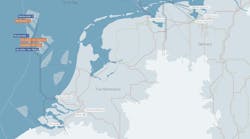Offshore staff
GLASGOW, UK – Fugro has delivered a motion dataset from the BOP stack and lower riser of two deepwater wells in the Barents Sea.
During drilling, the client required recording of motion and strain of the wellhead, BOP, and riser to quantify fatigue damage to the wellhead. Fugro deployed its Wellhead and Riser Instrumentation Service (WARIS), comprising a specialist engineering team and six modular, self-contained DeepData pods. The latter form the core of a data acquisition system using accelerometers and angular rate sensors to determine motions and rotation at specified locations.
Fugro applied a set of clamp-on subsea strain gauges. The modular logging system, operating in water depths of up to 1,400 m (4,593 ft), collected and analyzed data from sensors at various wellhead locations. An ROV was used for data recovery and battery replacement.
According to Fugro, the DeepData pods achieved a 100% data recording success rate on this job during a deployment of almost one year. The client plans to use the data to build a history of the wellhead fatigue and to recalibrate the fatigue model of the riser. This should facilitate detailed analysis of vortex-induced vibrations and wellhead fatigue so that the remaining fatigue life of the assets can be estimated, allowing the client to manage well interventions more effectively in the longer term, Fugro claims.
08/04/2014




